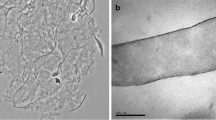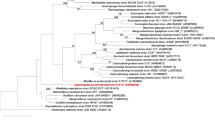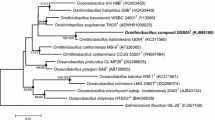Abstract
Two strains of S-citramalate-fermenting strictly anaerobic non-spore-formers were isolated in pure culture from anoxic mud samples of a creek and from a pond. One of them (strain CreCit 1) was studied in detail. It stained gram-negative, and contained β-hydroxymyristic acid. Nitrate, sulfate and other sulfur compounds were not utilized as electron acceptors. S-citramalate, citrate, mesaconate, and pyruvate were utilized as substrates; but R-citramalate, citraconate, l-glutamate, and carbohydrates not. S-citramalate was fermented to acetate, formate, and hydrogen. Citrate, mesaconate, and pyruvate were fermented to acetate and formate. The DNA base ratio was 59 mol% guanine plus cytosine. Strain CreCit 1 is described as a member of a new genus and a new species in the family Bacteroidaceae, Formivibrio citricus gen. nov., sp. nov.
Similar content being viewed by others
References
Allison MJ, Dawson KA, Mayberry WR, Foss JG (1985) Oxalobacter formigenes gen. nov., sp. nov.: oxalate-degrading anaerobes that inhabit the gastrointestinal tract. Arch Microbiol 141: 1–7
Antranikian G, Friese C, Quentmeier A, Hippe H, Gottschalk G (1984) Distribution of the ability for citrate utilization amongst Clostridia. Arch Microbiol 138: 179–182
Blenden DC, Goldberg HS (1965) Silver impregnation stain for Leptospira and flagella. J Bacteriol 89: 899–900
Bryant MP, Small N (1956) Characteristics of two new genera of anaerobic curved rods isolated from the rumen of cattle. J Bacteriol 72: 22–26
Bryant MP (1972) Commentary on Hungate technique for culture of anaerobic bacteria. Am J Clin Nutr 25: 1324–1328
Bryant MP (1984) Genus XIII Lachnospira In: Sneath PHA, Mair NS, Sharpe ME, Holt JG (eds) Bergey's mannual of systematic bacteriology, Williams & Wilkins, Baltimore, pp 661–662
Buckel W, Barker HA (1974) Two pathways of glutamate fermentation by anaerobic bacteria. J Bacteriol 117: 1248–1260
Cataldo DA, Haroon M, Schrader LE, Young VL (1975) Rapid colorimetric determination of nitrate in plant tissue by nitration of salicylic acid. Commun Soil Sci Plant Anal 6: 71–80
Cline E (1969) Spectrophotometric determination of hydrogensulfide in natural waters. Limmnol Oceanogr 14: 454–458
Dehning I, Schink B (1989) Two new species of anaerobic oxalate-fermenting bacteria, Oxalobacter vibrioformis sp. nov. and Clostridium oxalicum sp. nov., from sediment samples. Arch Microbiol 153: 79–84
Hollaus F, Sleytr U (1972) On the taxonomy and fine structure of some hyperthermophilic saccharolytic clostridia. Arch Mikrobiol 86: 129–146
Hoskins JK (1934) Most probable numbers for evaluation of coli-aerogenes tests by fermentation tube method. Public Health Rep Washington 49: 393–405
Klemps R, Cypionka H, Widdel F, Pfennig N (1985) Growth with hydrogen, and further physiological characteristics of Desulfotomaculum species. Arch Microbiol 143: 203–208
Lechevalier H (1977) Lipids in bacterial taxonomy — a taxonomists view. CRC Crit Rev Microbiol 5: 109–210
Magee CM, Rodeheaver G, Edgerton FR (1975) A more reliable Gram staining technique for diagnosis of surgical infections. Am J Surg 130: 341–346
Patel GB, Khan AW, Agnew BJ, Colvin JR (1980) Isolation and characterization of an anaerobic, cellulolytic microorganism, Acetivibrio cellulolyticus gen. nov. sp. nov. Int J Syst Bacteriol 30: 179–185
Patel GB (1984) Genus XII Acetivibrio In: Sneath PHA, Mair NS, Sharpe ME, Holt JG (eds), Bergey's mannual of systematic bacteriology, Williams & Wilkins, Baltimore, pp 658–661
Pfennig N (1978) Rhodococcus purpureus gen. nov. and sp. nov., a ringshaped vitamin B12-requiring member of the family Rhodospirillaceae. Int J Syst Bacteriol 28: 283–288
Schlegel HG (1985)Allgemeine Mikrobiologie, (6th edn). Thieme, Stuttgart, pp 295–296
Schleifer KH, Kandler O (1972) Peptidoglycan types of bacterial cell walls and their taxonomic implications. Bacteriol Rev 36: 407–477
Seitz H-J, Cypionka H (1986) Chemolithotrophic growth of Desulfovibrio desulfuricans with hydrogen coupled to ammonification of nitrate or nitrite. Arch Microbiol 146: 63–67
Stieb M, Schink B (1984) A new 3-hydroxybutyrate fermenting anaerobe, Ilyobacter polytropus, gen. nov., sp. nov., possessing various fermentation pathways. Arch Microbiol 140: 139–146
Tamaoka J, Komagata K (1984) Determination of DNA base composition by reversed-phase high-performance liquid chromatography. FEMS Microbiol Lett 25: 125–128
Tanaka K, Pfennig N (1988) Fermentation of 2-methoxyethanol by Acetobacterium malicum sp. nov. and Pelobacter venetianus. Arch Microbiol 149: 181–187
Tanaka K, Nakamura K, Mikami E (1990a) Fermentation of maleate by a gram-negative strictly anaerobic non-spore-former, Propionivibrio dicarboxylicus gen. nov., sp. nov. Arch Microbiol 154: 323–328
Tanaka K, Nakamura K, Mikami E (1990b) Fermentation of cinnamate by a mesophilic strict anaerobe, Acetivibrio multivorans sp. nov. Arch Microbiol 155: 120–124
Tschech A, Pfennig N (1984) Growth yield increase linked to caffeate reduction in Acetobacterium woodii. Arch Microbiol 137: 163–167
Widdel F, Pfennig N (1981) Studies on dissimilatory sulfate-reducing bacteria that decompose fatty acids. I. Isolation of new sulfate-reducing bacteria enriched with acetate from saline environments. Description of Desulfobacter postgatei gen. nov., sp. nov. Arch Microbiol 129: 395–400
Author information
Authors and Affiliations
Rights and permissions
About this article
Cite this article
Tanaka, K., Nakamura, K. & Mikami, E. Fermentation of S-citramalate, citrate, mesaconate, and pyruvate by a gram-negative strictly anaerobic non-spore-former, Formivibrio citricus gen. nov., sp. nov.. Arch. Microbiol. 155, 491–495 (1991). https://doi.org/10.1007/BF00244967
Received:
Accepted:
Issue Date:
DOI: https://doi.org/10.1007/BF00244967




